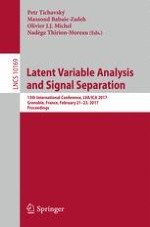
2017 | OriginalPaper | Buchkapitel
Higher-Order Block Term Decomposition for Spatially Folded fMRI Data
verfasst von : Christos Chatzichristos, Eleftherios Kofidis, Yiannis Kopsinis, Manuel Morante Moreno, Sergios Theodoridis
Erschienen in: Latent Variable Analysis and Signal Separation
Aktivieren Sie unsere intelligente Suche, um passende Fachinhalte oder Patente zu finden.
Wählen Sie Textabschnitte aus um mit Künstlicher Intelligenz passenden Patente zu finden. powered by
Markieren Sie Textabschnitte, um KI-gestützt weitere passende Inhalte zu finden. powered by